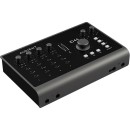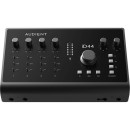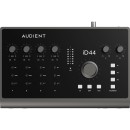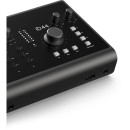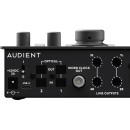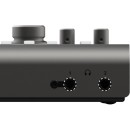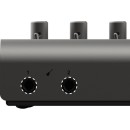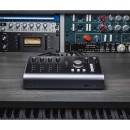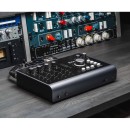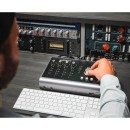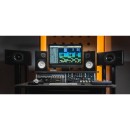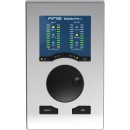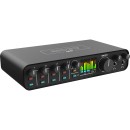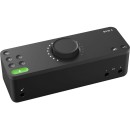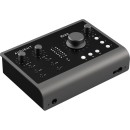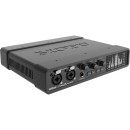Audient ID44 MkII Audio Interface Review
- 20 inputs and 24 outputs for extensive connectivity options.
- 4 Audient Console mic preamps with 60dB of gain.
- 2 JFET instrument inputs for high-quality direct recording.
- ADAT I/O for expanding your interface with additional preamps.
- High-performance AD/DA converters for pristine audio quality.
- 2 fully balanced inserts for integrating outboard gear.
- Monitor control with dedicated speaker outputs.
- 3 user-defined function buttons for quick access to key features.
- USB 2.0 connectivity for reliable and fast data transfer.
- Low-latency DSP mixer for zero-latency monitoring.
Specifications, Advantages, and Disadvantages
The Audient ID44 MkII 20x24 Desktop USB Audio Interface is a professional-grade audio interface designed for musicians, producers, and audio engineers seeking high-quality sound and extensive functionality. Featuring four Class-A Audient console mic preamps, the ID44 MkII ensures pristine audio capture with ultra-low noise and distortion, delivering a transparent and natural sound. The interface supports up to 20 inputs and 24 outputs, making it highly versatile for complex recording and mixing sessions.
Equipped with high-performance AD/DA converters, the ID44 MkII offers a dynamic range of 126dB, ensuring accurate and detailed audio playback and recording. Its USB 2.0 connection ensures compatibility with a wide range of computers, while maintaining low latency performance. The interface also includes dual independent headphone outputs, each with their own volume control, and two JFET instrument inputs for direct recording of guitars and other instruments.
The Audient ID44 MkII boasts a robust and intuitive design, featuring a solid metal chassis and a user-friendly interface. The ScrollControl feature allows the main volume knob to control various software parameters, enhancing workflow efficiency. Additionally, the interface includes comprehensive software integration with Audient's ID Mixer software, providing flexible routing, monitoring, and mixing capabilities. Overall, the ID44 MkII stands out as a reliable and feature-rich tool for professional audio production.
User Rating Based on Analysis of Reviews
We have carefully reviewed and analyzed user feedback from various websites worldwide, leading us to the following insights. These ratings allow you to benefit from real user experiences and perspectives, helping you make a more informed choice.
Purchase Value
85% of users found the Audient ID44 MkII to be a great investment, praising its rich feature set and robust build quality relative to its price. Many users appreciated the high-quality preamps and conversion capabilities that rival more expensive interfaces, making it a strong contender for both home and professional studios.
15% of users felt that the interface was slightly overpriced, especially considering the competition that offers similar features at a lower cost. Some users also expected bundled software or additional accessories, which they believed would have increased the overall value.
Audio Quality
90% of users were impressed by the pristine audio quality delivered by the Audient ID44 MkII. They highlighted the clear and transparent sound, high-quality DACs, and clean gain from the preamps as major strengths, contributing to an excellent recording and mixing experience.
10% of users encountered issues with audio quality, often related to their specific setup or external noise interference. A few users expected an even higher fidelity experience, especially those transitioning from high-end professional equipment.
Build Quality
88% of users were satisfied with the sturdy and durable construction of the Audient ID44 MkII. The solid metal chassis and well-designed controls were frequently mentioned as elements that contributed to a sense of reliability and longevity.
12% of users noted concerns with certain knobs or buttons feeling less durable, expressing worry about potential long-term wear and tear. Some also mentioned issues with the weight of the device, which could be a concern for those needing a more portable interface.
Ease of Use
82% of users found the Audient ID44 MkII easy to use, with an intuitive layout that simplifies the recording process. The inclusion of user-friendly software and clear documentation helped many users quickly get up to speed with the device's functions.
18% of users experienced a learning curve, especially if they were new to using audio interfaces. Some felt that the software could be more intuitive, and a few users encountered compatibility issues with specific DAWs or operating systems.
Connectivity Options
87% of users appreciated the extensive connectivity options available with the Audient ID44 MkII, including ADAT expandability and multiple outputs, which accommodate diverse recording setups and expand future flexibility.
13% of users were dissatisfied with the lack of certain digital connections, such as Thunderbolt, which they felt would have enhanced the interface's versatility and future-proofing capabilities.
Customer Support
80% of users reported positive experiences with Audient's customer support, finding the team responsive and helpful in resolving technical issues or answering product questions.
20% of users encountered delays in receiving support or found the assistance provided insufficient for resolving complex technical problems, leading to frustration and extended downtime.
Driver Stability
83% of users experienced stable and reliable performance from the Audient ID44 MkII drivers, noting seamless integration with various DAWs and minimal latency during recording sessions.
17% of users faced driver-related issues, including occasional crashes or compatibility problems, particularly on newer operating systems or with specific software updates.
Portability
70% of users who valued portability were relatively satisfied, appreciating the compact design that allows the Audient ID44 MkII to fit into mobile recording setups, despite being slightly larger than ultra-portable models.
30% of users found the device less portable than desired, with its weight and size making it cumbersome for frequent travel or quick on-the-go recording sessions.
Latency Performance
85% of users were pleased with the low latency performance of the Audient ID44 MkII, which allowed for smooth, real-time monitoring and seamless recording without noticeable delays.
15% of users encountered latency issues, often tied to their specific system configurations or when using resource-intensive plugins, which impacted their recording workflow.
Software Integration
78% of users found the interface's software integration satisfactory, with the provided software tools enhancing their recording capabilities and workflow efficiency.
22% of users were unhappy with the software integration, citing difficulties in setup or lack of advanced features compared to competitive offerings, which hindered their creative process.
Preamps Quality
92% of users were extremely satisfied with the quality of the preamps in the Audient ID44 MkII, praising their clean, transparent sound and sufficient gain for a wide range of microphones.
8% of users felt the preamps didn't meet their specific needs, often preferring a more colored sound or requiring additional external preamps for certain applications.
Expandability
90% of users valued the expandability options provided by the Audient ID44 MkII, particularly the ADAT ports, which allow for easy integration of additional inputs and outputs as their studio needs grow.
10% of users desired even more expandability options, such as additional built-in channels, to accommodate larger, more complex recording setups without relying on external gear.
Design and Aesthetics
86% of users appreciated the sleek and professional design of the Audient ID44 MkII, which not only looks attractive in a studio setup but also provides a logical and ergonomic interface layout.
14% of users were less impressed by the design, finding it either too utilitarian or preferring more visual flair and customizable aesthetic options to suit their personal studio style.
User Manual Quality
82% of users found the user manual to be comprehensive and clear, providing detailed information that helped them maximize the interface's features and troubleshoot any minor issues effectively.
18% of users criticized the manual for lacking depth in certain areas or failing to address specific technical questions, which necessitated additional research or reliance on customer support.
Compatibility with DAWs
88% of users reported excellent compatibility with a wide range of DAWs, appreciating the seamless integration and minimal setup required to get the Audient ID44 MkII working with their preferred software.
12% of users experienced compatibility issues, particularly with less common DAWs or older software versions, which required additional configuration or workarounds to resolve.
Monitoring Features
84% of users were satisfied with the monitoring features of the Audient ID44 MkII, particularly the customizable mixer software and multiple headphone outputs that cater to diverse monitoring needs.
16% of users desired more advanced monitoring options, such as additional independent headphone mixes or enhanced control over various monitoring settings, to better suit their specific recording scenarios.
Firmware Updates
80% of users appreciated the regular firmware updates provided by Audient, which often included performance enhancements and bug fixes that improved the overall functionality of the ID44 MkII.
20% of users found the update process cumbersome or encountered issues post-update, such as new bugs or compatibility problems, leading to frustration and a preference for more streamlined update procedures.
Learning Curve
75% of users felt comfortable navigating the features and controls of the Audient ID44 MkII after a brief adjustment period, aided by the intuitive design and supportive resources.
25% of users encountered a steeper learning curve, especially those new to advanced audio interfaces, requiring significant time and effort to fully understand and utilize all the available features.
Durability
85% of users were confident in the long-term durability of the Audient ID44 MkII, citing the high-quality materials and construction that withstand regular use without issues.
15% of users reported concerns with durability, particularly regarding specific components such as knobs or connectors, which they felt might not hold up under heavy or prolonged usage.
Value for Money
86% of users believed the Audient ID44 MkII offered excellent value for money, given its high-quality audio performance and professional-grade features that cater to serious recording enthusiasts and professionals alike.
14% of users felt the price point was high compared to similar offerings on the market, particularly for those who did not require all the advanced features or had a limited budget.
In the following sections, we will delve into the detailed specifications of the Audient ID44 MkII Audio Interface. Our review will also highlight the advantages and disadvantages of this product, providing a comprehensive analysis to help you make an informed decision.
Pros:
- High-quality preamps with versatile gain range.
- Expandable via ADAT for increased input/output options.
- Robust build quality with a sleek, professional design.
- Low-latency performance with stable drivers.
- Comprehensive control software for easy management.
Cons:
- Relatively higher price point compared to some competitors.
- Requires external power supply, limiting portability.
- No MIDI I/O, which may be a drawback for some users.
- Learning curve associated with advanced features.
General
| Channels of I/O | Analog: 4 Inputs / 8 Outputs at 96 kHz ADAT: 16 Inputs / 16 Outputs at 48 kHz S/PDIF: 2 Inputs / 2 Outputs |
|---|---|
| Maximum Sampling Rate | 96 kHz / 24-Bit |
| Number of Microphone Inputs | 4 Preamps |
| Built-In Microphone | |
| Input Level Adjustment | 4x Knob |
| Expansion Slots |
The specifications of the Audient ID44 MkII provide a detailed overview of its capabilities as an audio interface, making it a versatile choice for both recording and playback. Show More
Channels of I/O refers to the number of input and output channels available for connecting audio sources and sending audio signals. In this case, the ID44 MkII offers 4 analog inputs and 8 outputs at a sampling rate of 96 kHz, which allows for high-quality sound capture and playback. Additionally, it supports 16 channels of ADAT input and output at 48 kHz, giving users the flexibility to expand their setup with additional preamps or digital devices. The S/PDIF connection provides 2 inputs and outputs, useful for connecting digital audio sources. The variety of I/O options ensures that users can accommodate a range of recording and mixing scenarios.
Maximum Sampling Rate denotes the highest quality of audio that the interface can handle, which is specified as 96 kHz at 24-bit. This high sampling rate and bit depth allow for a more detailed and dynamic recording, capturing a wider range of frequencies and nuances in audio. This feature is particularly beneficial for professional audio work, where clarity and fidelity are paramount.
Number of Microphone Inputs indicates that the ID44 MkII is equipped with 4 preamps designed to accommodate microphone connections. This means that users can connect multiple microphones simultaneously for recording instruments or vocals, making it a suitable choice for various recording applications, including live sessions and studio work.
Built-In Microphone specifies that the ID44 MkII does not come with a built-in microphone, which is typical for professional audio interfaces. Users will need to provide their own microphones depending on their specific recording needs.
Input Level Adjustment features 4 knobs that allow for precise control over the input levels for each channel. This adjustment capability is crucial for achieving the right balance and preventing distortion during recording, ensuring that audio is captured clearly and accurately.
Expansion Slots indicates that the ID44 MkII does not include additional slots for expansion. While this may limit some users who wish to add extra functionality directly into the interface, the existing features and I/O options are robust enough to handle a wide range of audio tasks without the need for additional hardware.
Overall, these specifications showcase the Audient ID44 MkII as a powerful tool for audio professionals, providing various connectivity options and high-quality audio processing capabilities.
Signal Processing
| Pad | Mic/Line: -10 dB (Switchable per Channel) |
|---|---|
| Gain/Trim Range | Combo XLR-1/4" Mic/Hi-Z Inputs: 0 to +60 dB Line Inputs: -10 to +50 dB |
| High-Pass Filter | 100 Hz, 12 dB/Octave |
| Solo/Mute | Mute per Master |
The Audient ID44 MkII features a range of specifications designed to enhance audio recording and playback quality. Show More
The Pad: Mic/Line option provides a switchable -10 dB attenuation per channel. This feature is particularly useful when recording high-output sources, such as guitar amplifiers or loud vocals, as it prevents distortion by lowering the input level before it reaches the preamp. Users can easily engage or disengage this pad based on their recording needs.
The Gain/Trim Range is vital for achieving optimal recording levels. The combo XLR-1/4" Mic/Hi-Z inputs offer a gain range from 0 to +60 dB, allowing for a wide variety of microphones and instruments to be accurately captured. The line inputs have a gain range of -10 to +50 dB, accommodating both low and high-level signals. This flexibility ensures that users can achieve the desired sound without unwanted noise or distortion.
The High-Pass Filter operates at 100 Hz with a 12 dB/Octave slope. This feature helps eliminate low-frequency rumble and unwanted background noise, resulting in clearer recordings. By filtering out these frequencies, it allows the user to focus on the desired audio without interference from low-end disturbances.
Lastly, the Solo/Mute functionality allows for individual channel muting or soloing per master. This is especially useful during mixing, as it permits users to isolate specific tracks for detailed listening or to mute others temporarily without affecting the overall mix. This flexibility aids in achieving a balanced and polished final product.
Connectivity
| Analog Audio I/O | 4x Combo XLR-1/4" TRS Balanced Mic/Line Input 2x 1/4" TS Unbalanced Hi-Z Input 4x 1/4" TRS Balanced Line Output 2x 1/4" TRS Unbalanced Headphone Output 1x 1/8" / 3.5 mm TRS Unbalanced Headphone Output 2x 1/4" TRS Balanced Insert Send 2x 1/4" TRS Balanced Insert Return |
|---|---|
| Phantom Power | 48 V ± 4 V (Selectable on Individual Inputs) |
| Phantom Power Current | 10 mA per Channel |
| Digital Audio I/O | 2x TOSLINK Optical ADAT / S/PDIF Input (S/MUX Support) 2x TOSLINK Optical ADAT / S/PDIF Output (S/MUX Support) |
| Host Connection | 1x USB-C |
| Host Connection Protocol | USB 2.0 |
| USB (Non-Host) | |
| Sync I/O | 1x BNC Word Clock Output |
| Network I/O | |
| MIDI I/O |
The Audient ID44 MkII is equipped with a variety of analog audio input and output options designed to cater to different recording and monitoring needs. The specifications include 4 combo XLR-1/4" TRS balanced mic/line inputs, allowing for the connection of both microphones and line-level sources. Additionally, it features 2 unbalanced Hi-Z inputs, ideal for directly connecting high-impedance instruments like electric guitars. The unit also offers 4 balanced line outputs for sending audio to monitors or other equipment, alongside 2 unbalanced headphone outputs for monitoring. The inclusion of balanced insert sends and returns provides flexibility for integrating external effects processors into your signal chain.Show More
Phantom power is crucial for powering condenser microphones, and the ID44 MkII offers selectable 48V phantom power on individual inputs, which can deliver up to 10 mA per channel. This specification ensures compatibility with a wide range of microphones, enhancing your recording options.
In terms of digital audio connectivity, the interface supports 2 TOSLINK optical ADAT/S/PDIF inputs and outputs, with S/MUX support for high-quality digital audio transfer. This is particularly beneficial for expanding your setup with additional digital devices or for integrating with other digital audio systems. The connection to a host computer is facilitated by a USB-C port, utilizing USB 2.0 protocol, which ensures reliable data transfer.
Although the ID44 MkII does not include network I/O or MIDI capabilities, it features a BNC Word Clock output for synchronization with other digital audio equipment. This ensures that your recordings remain tightly aligned in multi-device setups, maintaining audio integrity across the board.
Performance
| Frequency Response | Mic, Line Inputs: 10 Hz to 65 kHz ±0.5 dB Hi-Z Inputs: 10 Hz to 50 kHz ±0.5 dB AD/DA Converters: 10 Hz to fs/2 ±0.5 dB Headphone Outputs: 10 Hz to fs/2 ±0.5 dB |
|---|---|
| Maximum Input Level | Mic Inputs: +18 dBu +28 dBu (with Pad) Line Inputs: 28 dBu Hi-Z Inputs: +10 dBu Insert Return: +18 dBu |
| Maximum Output Level | Line Outputs: +18 dBu Insert Send: +22 dBu Headphone Outputs: +14 dBu |
| Headphone Output Power | 225 mW into 30 Ohms 210 mW into 60 Ohms 54 mW into 600 Ohms |
| Impedance | Mic Inputs: 3 Kilohms (Balanced) Line Inputs: 10 Kilohms (Balanced) Hi-Z Inputs: 1 Megohm (Unbalanced) Insert Return: > 10 Kilohms (Balanced) Insert Send: < 100 Ohms (Balanced) D/A Converters: < 100 Ohms (Balanced) Headphone Outputs: < 50 Ohms (Balanced) |
| Dynamic Range | A/D Converters: 120 dB (A-Weighted) D/A Converters: 126 dB (A-Weighted) Headphone Outputs: 124 dB (A-Weighted) |
| SNR | Mic/Line Inputs: 96 dB Hi-Z Inputs: 95 dB (A-Weighted) |
| THD+N | Mic Inputs: -96 dBu / < 0.003% (1 kHz) Hi-Z Inputs: < 0.3% (1 kHz) A/D Converters: -112 dB / < 0.0003% (1 kHz, at -1 dBFS) D/A Converters: -104 dB / < 0.0006% (1 kHz, at -1 dBFS) Headphone Outputs: -103 dB / < 0.0008% (1 kHz, at -1 dBFS) |
| EIN | Mic Inputs: -126 dBu |
| CMRR | Mic Inputs: > 80 dB (1 kHz) |
The Frequency Response specification indicates the range of frequencies that the audio interface can effectively handle. For instance, the mic and line inputs cover 10 Hz to 65 kHz, which means they can capture low bass sounds as well as high-frequency content, ensuring a full and rich audio signal. The high-impedance (Hi-Z) inputs have a slightly narrower range of 10 Hz to 50 kHz, which is still quite adequate for most recording needs. This broad frequency response allows the interface to accurately reproduce sound without coloration.Show More
The Maximum Input Level is crucial for determining how strong of a signal the interface can accept without distortion. For instance, the mic inputs can handle +18 dBu, while the line inputs can manage up to 28 dBu. This high input level capability is essential for recording loud sources without clipping, ensuring clean and professional-quality audio.
Similarly, the Maximum Output Level indicates the highest output signal the interface can deliver to external equipment, such as speakers or headphones. The line outputs can reach +18 dBu, and the headphone outputs can deliver up to +14 dBu. This ensures that enough power is available for driving various audio equipment without losing signal integrity.
The Headphone Output Power specifies how much power is delivered to connected headphones at various impedances. With 225 mW into 30 Ohms, the interface can drive even demanding headphones effectively, providing sufficient volume and clarity without distortion.
The Impedance values for different input types influence the interface's compatibility with various audio sources. For instance, the mic inputs have an impedance of 3 Kilohms, which is suitable for most microphones, while the Hi-Z inputs at 1 Megohm are designed for high-impedance instruments like electric guitars.
The Dynamic Range represents the difference between the lowest and highest levels of audio that can be processed without distortion or noise. With 120 dB for A/D converters and 126 dB for D/A converters, the Audient ID44 MkII provides a high dynamic range, ensuring that both quiet and loud sounds are captured accurately.
The SNR (Signal-to-Noise Ratio) measures the level of desired signal compared to background noise. With values around 96 dB for mic/line inputs and 95 dB for Hi-Z inputs, this indicates that the interface can deliver clean audio with minimal noise interference.
The THD+N (Total Harmonic Distortion + Noise) indicates the level of unwanted distortion added to the audio signal. With figures as low as -112 dB for A/D converters, this suggests that the interface maintains high fidelity, ensuring that the output signal closely resembles the original source.
The EIN (Equivalent Input Noise) for mic inputs at -126 dBu is a measure of the noise floor of the interface, indicating low self-noise, which is beneficial for capturing quiet sounds without adding unwanted noise.
Lastly, the CMRR (Common Mode Rejection Ratio) for mic inputs at > 80 dB indicates the interface's ability to reject unwanted noise that may be induced in the signal lines, further ensuring that the audio recorded is clean and free from interference.
Digital Audio
| dBFS Reference Level | +18 dBu = 0 dBFS |
|---|---|
| Sample Rates | Up to 96 kHz |
| Sample Rate Conversion | |
| Bit Depths | 24-Bit |
| Latency | 0.677 ms at 44.1 kHz (Dependent on Buffer Size, Input to Output) 0.625 ms 0.354 ms at 88.2 kHz 0.323 ms at 96 kHz (Input to Output) |
| Sync Sources | ADAT, Internal, S/PDIF |
The specifications of the Audient ID44 MkII 20x24 Desktop USB Audio Interface provide a comprehensive overview of its capabilities. Show More
Starting with the dBFS Reference Level, this specification indicates the relationship between the analog signal level and the digital full scale (dBFS) in the audio interface. A reference level of +18 dBu means that when the analog signal reaches this level, it corresponds to 0 dBFS in the digital domain. This is important for ensuring optimal headroom and avoiding distortion when recording or mixing audio.
The Sample Rates supported by the ID44 MkII go up to 96 kHz, which allows for high-resolution audio capture and playback. Higher sample rates enable more accurate reproduction of sound, making them particularly beneficial for professional recording environments where detail and clarity are crucial.
The Sample Rate Conversion feature is not present in this interface, meaning that users will need to manage sample rates externally if required. This could be a consideration for those working with multiple devices that operate at different sample rates.
In terms of Bit Depths, the ID44 MkII supports 24-bit audio. This level of bit depth allows for a greater dynamic range and finer detail in audio recordings, which is essential for professional audio applications.
The Latency figures provided indicate the time delay between input and output signals at various sample rates. With a low latency of 0.677 ms at 44.1 kHz and even lower at higher sample rates, this interface ensures that musicians and audio engineers can monitor in real-time without noticeable delays, which is critical for live performances and recordings.
Finally, the Sync Sources available include ADAT, Internal, and S/PDIF. These options allow for flexible synchronization with other audio devices, ensuring that the ID44 MkII can integrate seamlessly into various studio setups. Whether connecting to digital converters or other interfaces, having multiple sync options enhances the versatility of the audio interface.
Audio Storage & Playback
| Memory Card Slot |
|---|
The specification "Memory Card Slot: No" indicates that the Audient ID44 MkII does not come equipped with a slot for memory cards. This feature is typically found in devices that allow for direct recording or playback from removable storage, such as digital audio recorders or some interfaces designed for mobile use. Show More
In the context of the ID44 MkII, the absence of a memory card slot means that users will rely on USB connectivity to interface with their computers and recording software for audio input and output. This design choice prioritizes a streamlined workflow and minimizes potential points of failure associated with removable media. As a result, users can expect a more stable and direct connection for high-quality audio processing, making it suitable for professional studio environments where reliability and performance are essential.
Compatibility
| OS Compatibility | macOS 10.11.6 or Later Windows 8 or Later (32-/64-Bit) |
|---|---|
| Processor Requirement | Mac: Intel Apple PC: 1.6 GHz Intel Core 2 AMD |
| RAM Requirements | 1 GB |
| Mobile Device Compatibility | |
| Required Hardware | USB 2.0 Port USB Cable (Included) |
| Internet Connection | Required for Registration, Software/Driver Download |
The OS Compatibility feature indicates the operating systems that the Audient ID44 MkII can work with. It supports macOS versions from 10.11.6 and later, as well as Windows 8 and above in both 32-bit and 64-bit formats. This ensures that users on these platforms can effectively utilize the audio interface without compatibility issues, allowing for a seamless recording and mixing experience.Show More
The Processor Requirement specifies the minimum processing power needed for optimal performance. For Mac users, an Intel or Apple processor is necessary, while PC users should have at least a 1.6 GHz Intel Core 2 or AMD processor. This requirement ensures that the interface can handle audio processing tasks without latency or performance glitches, crucial for professional audio work.
The RAM Requirements detail the minimum amount of RAM needed to run the device efficiently, which is set at 1 GB. Adequate RAM is essential for multitasking and managing multiple audio tracks, as it allows for smoother operation and better overall performance when using audio software.
Under Mobile Device Compatibility, it is noted that the Audient ID44 MkII does not support mobile devices. This means the interface is designed specifically for desktop or laptop setups, making it suitable for studio environments rather than mobile recording.
The Required Hardware section highlights that a USB 2.0 port is necessary for connection, along with a USB cable that is included with the unit. This ensures that users have the essential hardware for a straightforward setup, allowing for easy integration with their existing systems.
Finally, the Internet Connection requirement states that an internet connection is needed for initial registration and to download any necessary software or drivers. This is important for ensuring that the device runs with the latest updates and features, enhancing its functionality and user experience.
Power
| Power Requirements | AC/DC Power Adapter (Included) |
|---|---|
| AC Input Power | 90 to 264 VAC, 50 / 60 Hz |
| AC/DC Power Adapter | 12 VAC at 2 A, Center-Positive (Included) |
The Power Requirements section of the Audient ID44 MkII provides essential details about the power supply needed to operate the device effectively. It specifies that an AC/DC power adapter is included with the interface, ensuring users have everything they need to get started without additional purchases.Show More
The AC Input Power range of 90 to 264 VAC indicates the versatility of the device, allowing it to function in various geographical locations with different voltage standards. This wide range ensures that users can use the interface reliably in many countries without worrying about power compatibility issues.
The AC/DC Power Adapter specification of 12 VAC at 2 A, Center-Positive further describes the power adapter's output, which is designed to provide the necessary voltage and current for optimal performance. The center-positive configuration is a standard connection type, making it easy for users to find compatible power supplies if the included adapter is lost or damaged. Overall, these power requirements highlight the device’s flexibility and reliability in different environments, which is crucial for both studio and live settings.
Physical
| Anti-Theft Features | Kensington Security Slot |
|---|---|
| Dimensions | 10.9 x 7.5 x 2.7" / 27.6 x 19.1 x 6.9 cm (Including Controls and Protrusions) |
The Anti-Theft Features of the Audient ID44 MkII include a Kensington Security Slot. This feature allows users to secure the audio interface to a fixed object, providing protection against theft in public or shared environments. This is particularly useful for professionals who may transport their gear frequently, ensuring peace of mind during sessions in various locations.Show More
The Dimensions of the Audient ID44 MkII are 10.9 x 7.5 x 2.7 inches (27.6 x 19.1 x 6.9 cm), including controls and protrusions. These dimensions indicate the physical footprint of the device, which is important for users who need to manage space in their studio setup or while traveling. A compact design allows for easy integration into existing workspaces, while still offering a robust set of features. The size also suggests portability, making it convenient for musicians and producers who work on the go.
Packaging Info
| Package Weight | 5.74 lb |
|---|---|
| Box Dimensions (LxWxH) | 14.5 x 9.5 x 4.5" |
The Package Weight indicates the overall weight of the Audient ID44 MkII audio interface when packaged for shipping. Weighing 5.74 lb, this weight gives an idea of the product's sturdiness and portability. A heavier weight can suggest a robust build quality, which is often desirable in professional audio equipment as it may be constructed with more durable materials. This factor is important for users who may transport the interface frequently, as a manageable weight can enhance convenience without compromising on quality.Show More
The Box Dimensions provide the physical size of the package, measuring 14.5 x 9.5 x 4.5 inches. These dimensions are crucial for potential users to consider when planning storage or transport, especially if they have limited space. Knowing the box size can also help in determining whether the interface will fit into standard carrying cases or racks. Additionally, appropriate packaging dimensions reflect on the overall design and layout of the product, ensuring that it is well-protected during transport while remaining easy to handle.
Videos
Customer Questions
How do I set up the Audient ID44 MkII with my computer?
To set up the Audient ID44 MkII with your computer, download and install the latest drivers from the Audient website. Connect the ID44 MkII to your computer using the provided USB cable, and then follow the on-screen instructions to complete the installation.
Why is my computer not recognizing the Audient ID44 MkII?
If your computer is not recognizing the Audient ID44 MkII, ensure that you have installed the latest drivers from the Audient website. Check that the USB cable is securely connected to both the interface and your computer. Also, try using a different USB port or cable to rule out connectivity issues.
How do I update the firmware on the Audient ID44 MkII?
To update the firmware on the Audient ID44 MkII, download the latest firmware update from the Audient website. Follow the instructions provided in the firmware update package to complete the update process.
Why am I experiencing latency issues with the Audient ID44 MkII?
Latency issues can be caused by various factors. Ensure that you have the latest drivers installed and that your DAW (Digital Audio Workstation) is configured correctly. Lower the buffer size in your DAW settings to reduce latency. Also, check that your computer meets the system requirements for the ID44 MkII.
How do I set up the ID44 MkII as my default audio device?
To set up the ID44 MkII as your default audio device, go to your computer's sound settings. Select the ID44 MkII from the list of available playback and recording devices. Set it as the default device for both playback and recording.
Why am I not getting any sound from my Audient ID44 MkII?
If you are not getting any sound from your ID44 MkII, check that your speakers or headphones are properly connected. Ensure that the correct input and output channels are selected in your DAW or audio settings. Also, verify that the gain and volume controls on the ID44 MkII are set correctly.
How do I use the monitor mix function on the Audient ID44 MkII?
To use the monitor mix function, open the Audient iD mixer software. You can create custom monitor mixes by adjusting the faders and panning for each input and software return. Save your mix settings for easy recall later.
What do I do if the Audient ID44 MkII is not powering on?
If the ID44 MkII is not powering on, check the power supply and ensure it is securely connected to the interface and a working power outlet. If the issue persists, try using a different power adapter or contact Audient support for further assistance.
Can I use the Audient ID44 MkII with an iPad or other mobile devices?
Yes, you can use the ID44 MkII with an iPad or other mobile devices that support USB audio interfaces. You will need a compatible adapter (such as the Apple Camera Connection Kit for iPads) to connect the interface to your mobile device.
How do I configure the digital inputs and outputs on the Audient ID44 MkII?
To configure the digital inputs and outputs, open the Audient iD mixer software. Navigate to the 'System' tab and select the appropriate sample rate and clock source. Connect your digital devices to the ADAT or S/PDIF ports and ensure they are synced correctly with the ID44 MkII.
Comparison
← SWIPE THE TABLE TO SEE MORE →
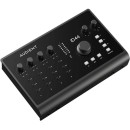
Audient ID44 MkII |
VS | |||||
|---|---|---|---|---|---|---|
| Analog: 4 Inputs / 8 Outputs at 96 kHz ADAT: 16 Inputs / 16 Outputs at 48 kHz S/PDIF: 2 Inputs / 2 Outputs |
Channels of I/O |
Analog: 4 Input / 4 Output Digital: 12 Input / 12 Output |
Analog: 6 Inputs / 4 Outputs |
Analog: 4 Inputs / 4 Outputs at 96 kHz |
10 Input / 14 Output |
Analog: 8 Inputs / 12 Outputs Digital: 10 Inputs / 10 Outputs |
| 96 kHz / 24-Bit | Maximum Sampling Rate | 192 kHz / 24-Bit | 192 kHz / 24-Bit | 96 kHz / 24-Bit | 96 kHz / 32-Bit | 192 kHz / 24-Bit |
| 4 Preamps | Number of Microphone Inputs | 2 Preamps | 4 Preamps | 4 Preamps | 2 Preamps | 2 Preamps |
| 4x Combo XLR-1/4" TRS Balanced Mic/Line Input 2x 1/4" TS Unbalanced Hi-Z Input 4x 1/4" TRS Balanced Line Output 2x 1/4" TRS Unbalanced Headphone Output 1x 1/8" / 3.5 mm TRS Unbalanced Headphone Output 2x 1/4" TRS Balanced Insert Send 2x 1/4" TRS Balanced Insert Return |
Analog Audio I/O |
2x XLR 3-Pin Balanced Mic/Line Input 2x 1/4" TS Unbalanced Line/Hi-Z Input 2x XLR 3-Pin Balanced Monitor Output 1x 1/4" TRS Unbalanced Headphone Output 1x 1/8" / 3.5 mm TRS Unbalanced Headphone Output |
4x Combo XLR-1/4" TRS Balanced/Unbalanced Mic/Line/Hi-Z Input 2x 1/4" TRS Balanced Line Input 2x 1/4" TRS Unbalanced Headphone Output 4x 1/4" TRS Balanced Line Output (DC-Coupled) |
4x Combo XLR-1/4" TRS Balanced Mic/Line Input (Pin 2 Hot) 1x 1/4" TS Unbalanced Hi-Z Input (Front Panel) 4x 1/4" TRS Balanced Line Output (Tip Hot) 2x 1/4" TRS Unbalanced Headphone Output |
2x Combo XLR-1/4" 3-Pin Mic/Line Input 1x 1/4" TS Unbalanced Hi-Z Input (Front Panel) 2x 1/4" TRS Balanced Insert Send 2x 1/4" TRS Balanced Insert Return 4x 1/4" TRS Balanced Monitor Output 1x 1/4" TRS Headphone Output (Front Panel) 1x 1/8" / 3.5 mm TRS Headphone Output (Front Panel) |
2x Combo XLR-1/4" TRS Balanced/Unbalanced Mic/Line/Hi-Z Input (Front Panel) 6x 1/4" TRS Balanced Line Input 10x 1/4" TRS Balanced Line Output (DC-Coupled) 1x 1/4" TRS Unbalanced Headphone Output (Front Panel) |
| 2x TOSLINK Optical ADAT / S/PDIF Input (S/MUX Support) 2x TOSLINK Optical ADAT / S/PDIF Output (S/MUX Support) |
Digital Audio I/O |
1x TOSLINK Optical ADAT / S/PDIF Input 1x TOSLINK Optical ADAT / S/PDIF Output |
- | - |
1x TOSLINK Optical ADAT / S/PDIF Input 1x TOSLINK Optical ADAT / S/PDIF Output |
1x TOSLINK Optical ADAT / S/PDIF Input 1x TOSLINK Optical ADAT / S/PDIF Output 1x RCA Coaxial S/PDIF Input 1x RCA Coaxial S/PDIF Output |
| 1x USB-C | Host Connection | 1x USB-B | 1x USB-C | 1x USB-C | 1x USB-C | 1x USB-C (Class-Compliant) |
| macOS 10.11.6 or Later Windows 8 or Later (32-/64-Bit) |
OS Compatibility |
macOS Windows |
macOS 10.11 or Later (64-Bit Only) macOS 10.13 or Later (64-Bit Only) Windows 10 or Later (64-Bit Only) |
macOS 10.7.5 or Later Windows 7 or Later (32-/64-Bit) |
Windows macOS |
macOS 10.11 or Later Windows 10 13.5 or Later |
| AC/DC Power Adapter (Included) | Power Requirements | AC/DC Power Adapter (Not Included), USB Bus Power | AC/DC Power Adapter (Included) | USB Bus Power | USB Bus Power | AC/DC Power Adapter (Included) |
